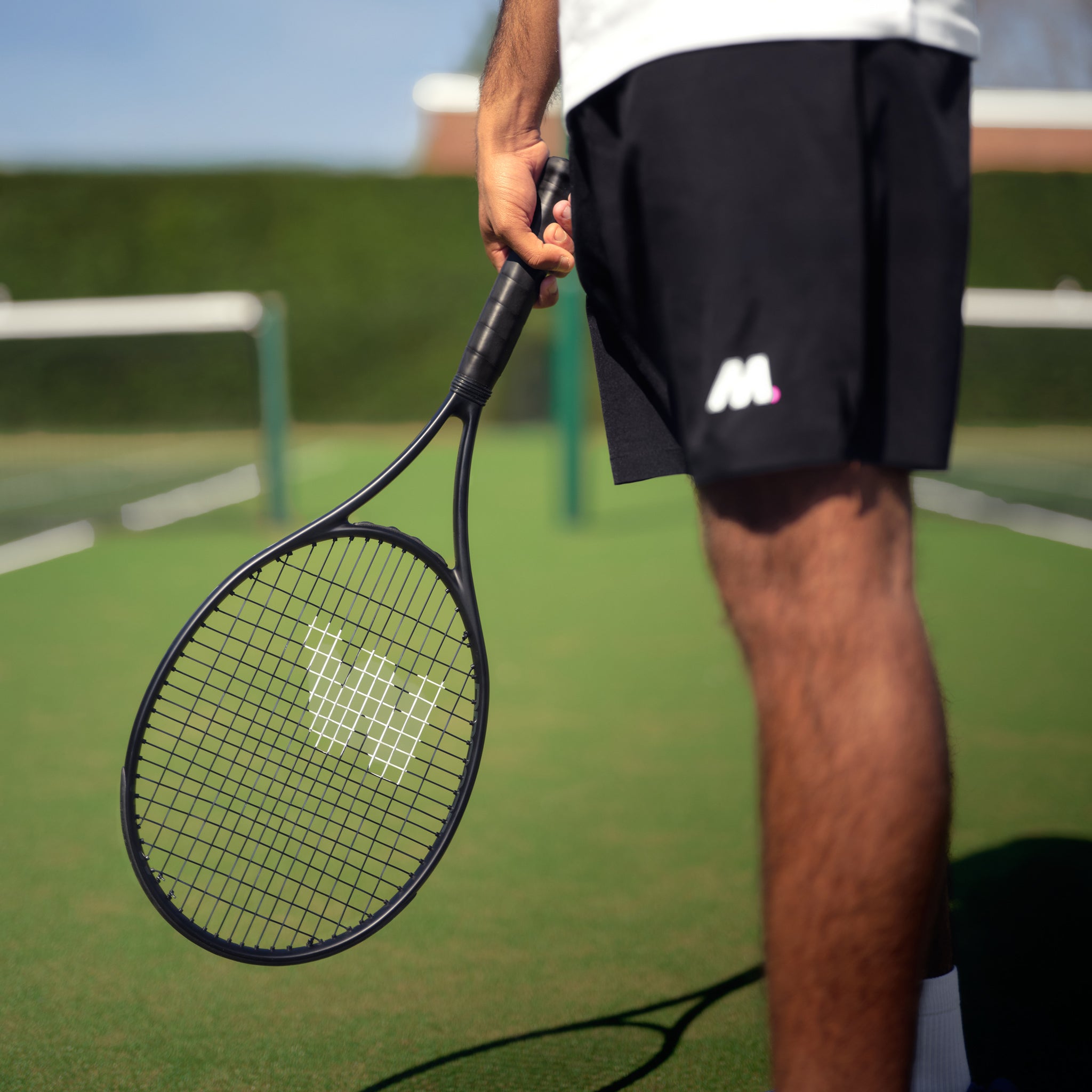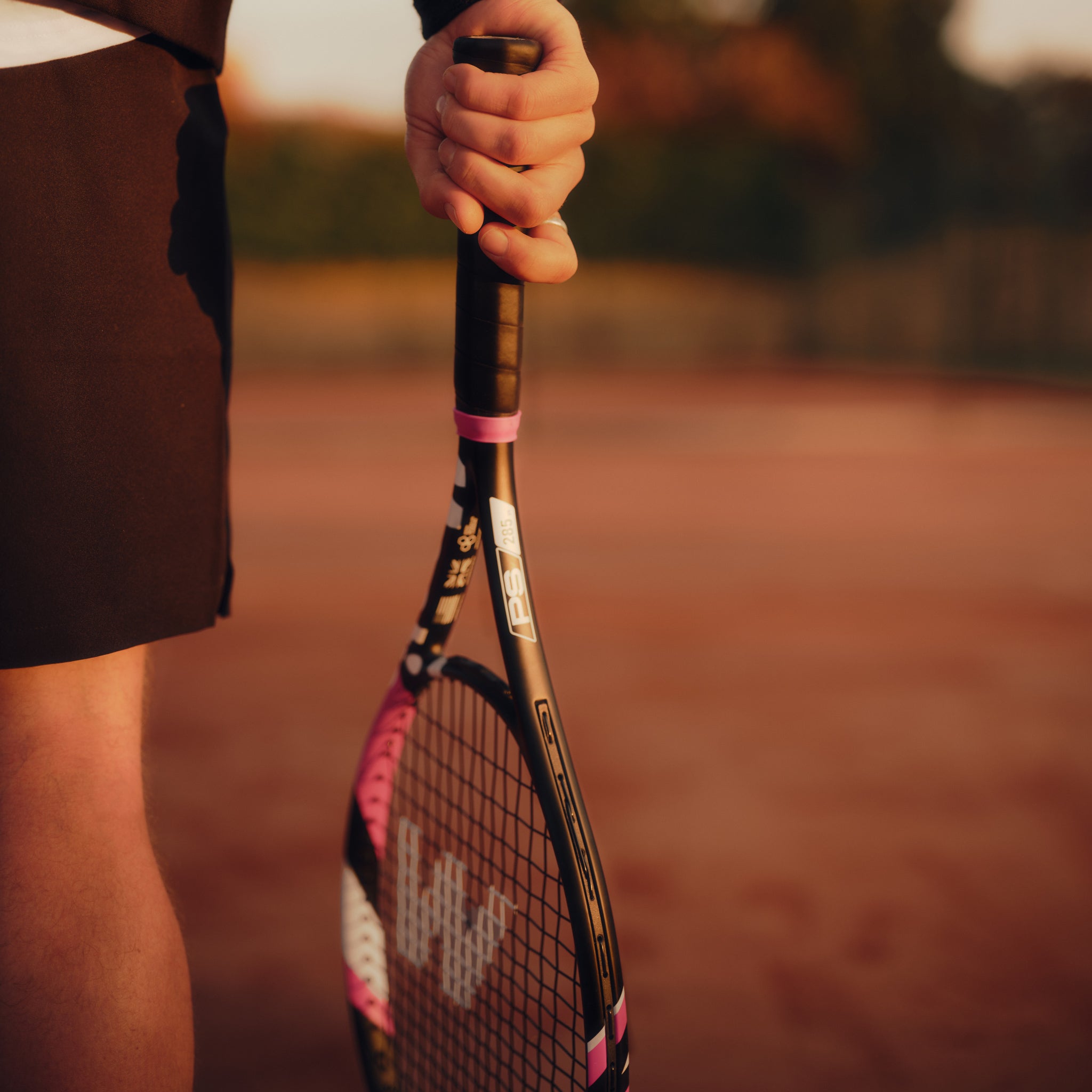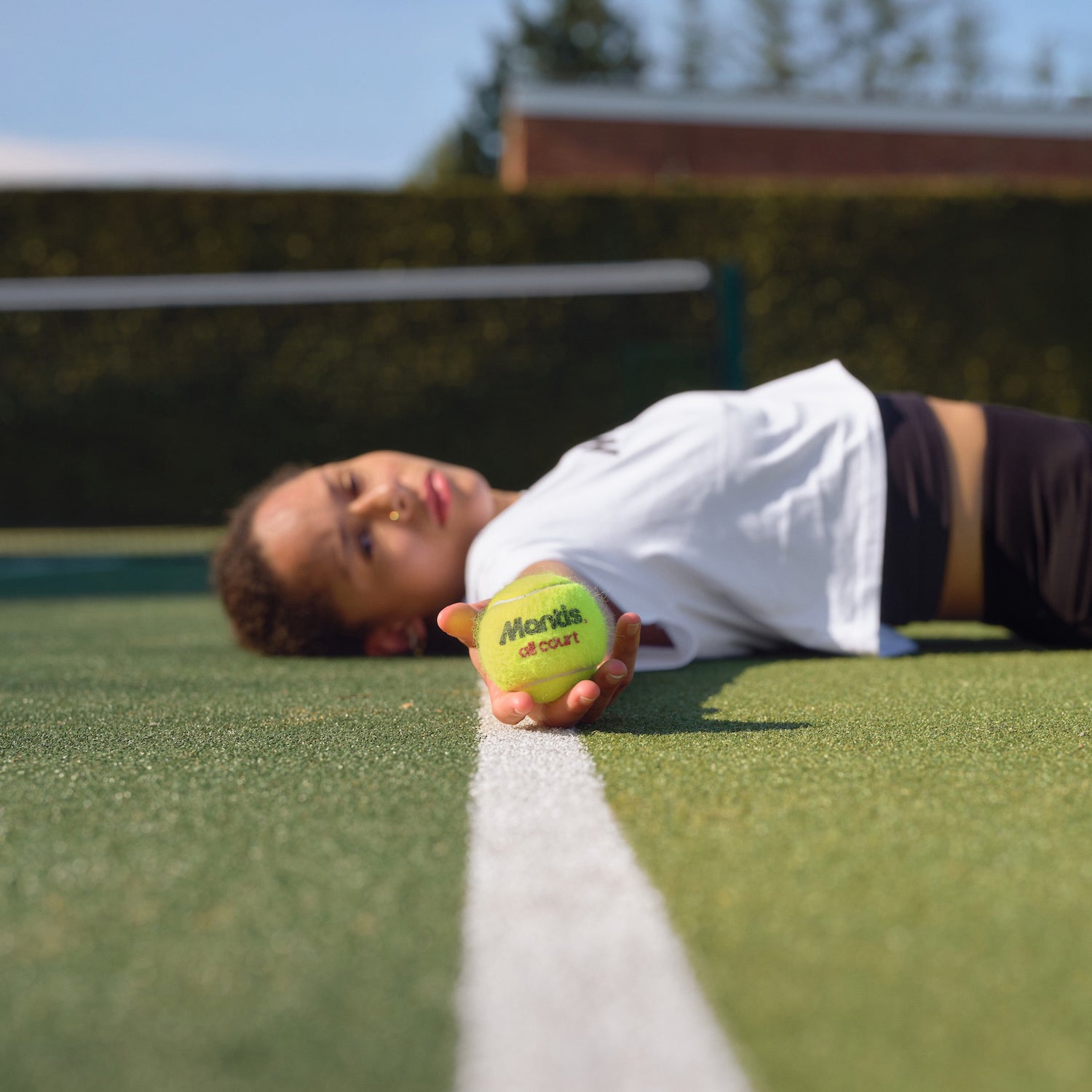
The best tennis rackets for spin usually have a few things in common: an open string pattern like 16x19, a mid-plus head size around 98-102 sq. in., and a frame built for speed. It's this combination that lets the strings really grab the ball, generating the kind of heavy topspin that has come to define the modern game. Our guide to understanding tennis racket specifications is a great place to start.
Understanding the Power of Spin in Modern Tennis
Spin has completely changed the way tennis is played. It's no longer just a way to get the ball back in play; it’s now an aggressive weapon. Heavy topspin creates higher, unpredictable bounces that can force opponents well behind the baseline and open up the court for sharp, angled winners.
At Mantis, we know that unlocking your spin potential starts with the right gear. The days of just hitting flat, hard shots are long gone, as players at every level look for that competitive edge through rotation. This guide will walk you through the essential features of a spin-friendly racket to help you find a frame that can seriously elevate your game.
The demand for this kind of specialised equipment is on the rise. In fact, the tennis racket market in the United Kingdom is seeing a noticeable upward trend, largely driven by players wanting frames that give them more spin and control. Between 2024 and 2035, the UK market is projected to grow steadily, with an expected size of 1.5 million units by 2035. This really highlights the shift towards performance-focused equipment.
Key Racket Characteristics for Spin
To find the best tennis rackets for spin, we need to focus on a few core specs. These elements have to work together to help you squeeze the maximum revolutions per minute (RPMs) out of every shot.
- Open String Pattern: A 16x19 pattern is the go-to for most spin rackets. Why? The wider spacing between the strings allows them to move more freely, dig into the ball's surface, and then snap back into position. This "snapback" effect is what generates massive rotation.
- Aerodynamic Beam: A racket that cuts through the air quickly means more racket head speed. Speed is a crucial ingredient for spin; quite simply, the faster you can swing the frame, the more spin you can impart on the ball.
- Head Size and Sweet Spot: While a bigger head size might seem more forgiving, most spin-oriented rackets sit in the 98-102 square inch range. This offers a fantastic blend of control and a generous sweet spot, giving you the confidence to take big, aggressive cuts at the ball.
At its core, generating spin is all about creating friction. The perfect spin racket is engineered to maximise the interaction between the ball and the stringbed, turning your swing speed into those heavy, dipping shots that drive opponents crazy.
Comparing Racket Attributes To Decide on Best Tennis Rackets for Spin
Different racket features contribute to spin in their own unique ways. Figuring out how they all interact is the key to choosing a frame that truly suits your style of play.
Here's a quick breakdown of how the most important attributes influence your spin potential.
| Racket Attribute | Impact on Spin Generation | Ideal for Players Who... |
|---|---|---|
| Open String Pattern | Maximises string movement and ball bite, creating higher RPMs. | Want easy access to topspin and a higher launch angle. |
| Thinner, Flexible Beam | Increases "dwell time" (how long the ball stays on the strings), letting skilled players brush up on the ball more effectively. | Have well-developed technique and generate their own power. |
| Head-Light Balance | Allows for a faster wrist snap and acceleration through the contact zone, boosting racket head speed. | Are aggressive baseliners who rely on quick, whippy swings. |
Ultimately, choosing the best tennis racket for spin comes down to finding the right mix of these features to complement your swing. In the next sections, we'll dive deeper into how brands are putting these technologies into practice.
Deconstructing Racket Technology for Spin
To really get what makes a racket a spin machine, you have to look past the marketing slogans and dig into its core engineering. At Mantis, we believe that knowing a racket’s design inside and out is the first step to choosing the right one for your game. Our guide to understanding tennis racket specifications is a great place to start. These technical details aren’t just numbers on a spec sheet; they’re the racket's DNA, dictating precisely how it grabs the ball to create rotation.
Armed with this knowledge, you can see past the hype and properly analyse a frame’s true spin potential. The best rackets for spin aren’t built around a single gimmick but from a smart combination of technologies all working together.
The Science of the String Pattern
The string pattern is probably the single most important factor for generating spin. An open pattern, like the very common 16x19 setup, simply means there are wider gaps between the strings. This design allows for two key things to happen at impact.
First, the ball sinks deeper into the stringbed, an effect players call "pocketing." Second, the strings have more room to slide sideways and then violently snap back into place. This "snapback" is the real engine of spin, gripping the felt of the ball and imparting huge rotation as it launches off the racket.
The European tennis market, where the UK is a major player, has fully embraced these open-pattern designs. In fact, forecasts for 2025 suggest Europe will hold 26.86% of the global market, with the UK alone making up 13.32% of that. This shows just how much demand there is for rackets built for the modern, spin-heavy game.
How Frame Stiffness and Beam Shape Contribute
A racket's stiffness, measured by its RA (Relative Stiffness) rating, also plays a huge part. A stiffer frame (higher RA) bends less when you hit the ball, which means it transfers more energy back into your shot. This can lead to more power, and when you combine that power with a fast swing, you get heavier spin.
On the other hand, a more flexible frame (lower RA) increases the ball's "dwell time"—how long it stays on the strings. This extended contact gives players with great technique a bit more time to brush up the back of the ball, creating spin through pure skill and feel.
The choice between a stiff or flexible frame often comes down to your swing style. A player who generates spin with raw power may prefer a stiffer frame, while a touch player might favour the enhanced feel of a more flexible one.
The shape of the racket’s beam—its cross-section—also makes a difference. Most modern spin rackets have an aerodynamic beam designed to cut through the air with less resistance. This lets you swing the racket faster without any extra effort. And since racket head speed is a key ingredient in the spin formula, a faster frame naturally offers more spin potential.
The Role of Swingweight and Balance
Swingweight is all about how heavy a racket feels when you swing it. A higher swingweight gives you more stability and "plough-through," helping you hit deep, heavy shots from the baseline. The trade-off is that it can be harder to get moving quickly.
A lower swingweight makes a racket feel more manoeuvrable and "whippy." This makes it easier to accelerate the racket head and use a quick wrist snap, which is crucial for that brushing motion that creates topspin. The very best rackets for spin strike a careful balance, providing enough mass for stability but not so much that it kills the speed you need to whip the racket through contact. This is what truly separates a good spin racket from a great one.
Comparing the Top Rackets for Spin
Choosing the right frame from the sea of options out there demands a proper side-by-side look. Here at Mantis, we're firm believers that to find the best tennis racket for spin, you need to understand the subtle but crucial differences in how they play. We’re not just going to list popular models; we're going to dive into a structured comparison, zeroing in on how specific technologies and materials translate to real-world spin, power, and control. Our guide to understanding tennis racket specifications is a great place to start.
Our evaluation is designed to be balanced, shining a light on the trade-offs baked into every racket's design. For instance, a frame built purely for monstrous spin might feel a bit twitchy or unstable on off-centre shots compared to a more control-focused stick. By digging into these details, you can weigh what matters most to your game.
The big takeaway here is how the racket head's angle and speed are the real engines of rotation. The best spin rackets are simply designed to amplify that principle.
Spin Generation vs Power Level
The first major point of comparison is the relationship between a racket's spin potential and its raw power. While they're often linked, they aren't the same thing. Some rackets deliver explosive power with decent spin, while others are all about generating massive rotation with a more reined-in power level.
On the other hand, a frame with a thinner, more flexible beam might give you less "free" power. That flexibility, however, increases the time the ball sits on the strings. This lets players with fast, clean swings generate spin through pure technique rather than brute force, offering a much better feel and precision.
The core trade-off is clear: Do you want the racket to provide the power so you can focus on swing speed for spin, or do you prefer generating your own pace with a more feel-oriented frame to truly shape the shot?
Analysing Feel and Comfort
Feel is subjective, but it’s absolutely critical. A racket’s feel comes down to its material blend, vibration-dampening tech, and its stiffness rating (RA). For a spin player, feeling connected to the ball is vital to know exactly how it's interacting with the stringbed.
Rackets built with advanced carbon composites and integrated dampening systems are engineered to filter out harsh vibrations without numbing the feedback. This results in a uniquely arm-friendly experience, a huge plus for players who rely on stiff polyester strings for maximum spin.
Choosing between them really comes down to personal taste and what your body needs.
- Softer, Dampened Feel: Great for players worried about tennis elbow or those who simply prefer a muted, comfortable response.
- Crisp, Raw Feel: A better fit for advanced players who demand precise feedback and have the mechanics to handle a stiffer frame.
Control and Stability Under Pressure
A racket’s spin potential is useless if you can't control where the ball lands, especially on a big point. In a spin racket, control is heavily influenced by head size, swingweight, and torsional stability.
Most of the best tennis rackets for spin land in the mid-plus head size category, usually between 98 and 100 square inches. This range is a fantastic compromise, giving you a generous sweet spot to rip spin without sacrificing the precision needed to hit your targets.
Swingweight is another massive factor. A higher swingweight provides more "plough-through," helping the racket resist twisting when it collides with a heavy ball. This is crucial when you’re returning a big serve or trying to redirect pace in a baseline battle. The catch is that a racket that's too heavy can be a beast to swing fast, which can actually limit your spin.
Finding a Spin Racket That Matches Your Game
Choosing the right racket for spin isn't about finding one single "best" frame. It's about finding the one that feels like a natural extension of your arm. The perfect racket is deeply personal; it needs to click with your unique strengths, your swing, and how you see the court. At Mantis, our goal is to help players find a frame that doesn't just create spin, but enhances their entire game. Our guide to understanding tennis racket specifications is a great place to start.
We saw this challenge come up a lot recently, especially with the explosion in tennis's popularity across the UK. In the first half of 2021 alone, racket sales in the UK shot up by a massive 76% in volume year-on-year, and 26% in value compared to 2019. This boom was driven mostly by new and returning players who, understandably, were looking for rackets that made it easier to generate spin and control the ball while they honed their skills.
This trend really drives home a crucial point: a racket that’s a weapon in the hands of a tournament player could feel clumsy and unhelpful for someone just starting out. That's why figuring out your player type is the essential first step to making a smart choice.
The Aggressive Baseliner
Aggressive baseliners live and die by dictating play from the back of the court. Their game is all about raw power and heavy, penetrating groundstrokes. They use topspin as an offensive weapon, hitting deep, high-kicking balls to push opponents onto their back foot and force a weak reply they can pounce on.
For this type of player, the racket needs to be a pure engine for both power and spin.
- Key Racket Specs: You'll want a mid-plus head size, typically around 100 sq. in., paired with a firm flex (65-70 RA) and an open 16x19 string pattern. An aerodynamic beam shape is also a must, as it helps you whip the racket through the air to generate that punishing head speed.
- How It Plays Out: Picture yourself in a grinding cross-court rally. Your goal is to step in and absolutely rip a forehand that dives sharply at your opponent's feet. A stiffer, spin-friendly racket gives you the stability and pop to pull off that shot again and again.
The All-Court Strategist
The all-court player is a master of variety. They use spin to build points tactically, not just to blast through their opponent. They’ll mix heavy topspin drives with biting slice backhands, cheeky drop shots, and crisp angled volleys. For them, tennis is more like a chess match.
This player needs a racket that offers a sublime blend of feel, control, and versatility.
For the all-court strategist, the best spin rackets are the ones that talk back. They need exceptional feedback and touch to feel completely connected to the ball, allowing them to manipulate its flight and rotation with pinpoint precision—whether they're hitting a kick serve or a feather-light drop volley.
A pure power racket just won't cut it here; it often feels too blunt and disconnected for the delicate shots this style requires. The focus shifts to frames with a more balanced profile, prioritising feel and responsiveness without giving up too much spin potential.
- Key Racket Specs: A slightly smaller 98 sq. in. head size can deliver that extra dose of precision. A more flexible frame (rated below 65 RA) allows the ball to sink into the strings for longer, giving you a greater sense of control. The swingweight should be high enough to keep the racket stable at the net, but not so hefty that it feels sluggish.
- How It Plays Out: You've just yanked your opponent wide with a heavy topspin forehand. As they scramble, you glide forward to cut off the court. You need a racket that’s solid enough to punch back a passing shot but also nimble enough to carve out a soft volley for the winner.
The Developing Intermediate Player
Intermediate players usually have the basics down but are still working on generating effortless racket head speed. For them, the ideal spin racket is one that offers easy access to spin without demanding a flawless, high-speed swing. The frame needs to do a bit of the heavy lifting, helping them get the ball up and over the net with plenty of margin for error.
- Key Racket Specs: Look for a lighter static weight (under 300g unstrung) with a head-light or even balance, which makes the racket much easier to swing fast. A forgiving 100 sq. in. head provides a generous sweet spot, and a firm beam helps inject power even when your swing is more compact.
- How It Plays Out: You're focusing on adding more shape and arc to your shots to cut down on unforced errors. A lighter, more powerful spin-friendly frame will help you naturally lift the ball, building the muscle memory and confidence you need to elevate your game. The fastest way to improve is to use a racket that works with you, not against you.
Tuning Your Racket with Strings and Tension
Picking a high-performance spin frame is a massive step forward, but it's really only half the battle. The strings and tension you choose are just as vital in defining how your racket actually performs on the court. For a complete rundown, our in-depth tennis string guide covers everything, but let's focus here on setups that will give you maximum spin.
Think of your stringbed like the tyres on a performance car. It’s the final point of contact with the ball and dictates just how much grip you can get. The right setup can turn a great racket into a perfectly tuned weapon, unlocking its full spin potential and giving you wicked control over the ball's rotation.
String Material: The Engine of Spin
The material your strings are made of is the biggest factor when it comes to spin. For spin-hungry players, the choice really boils down to two main categories: shaped co-polyester strings and the softer multifilaments. Each offers a completely distinct feel and performance profile.
Shaped co-polyester strings, often just called 'polys', are the top choice for serious spin generation. Unlike traditional round strings, these are engineered with distinct geometric profiles—think hexagonal, octagonal, or even twisted shapes. These sharp edges literally bite into the ball's surface, creating immense friction at impact.
This aggressive grip, paired with the slick, low-friction nature of polyester, allows the main strings to slide out of place and then violently snap back into position. This "snapback" effect is the real engine behind modern topspin.
On the other hand, multifilament strings are built from hundreds of tiny fibres woven together. They provide brilliant comfort and feel, but their softer, more textured surface simply doesn't produce the same level of bite or snapback as a poly. If spin is your number one priority, a shaped co-poly is almost always the way to go.
The Critical Role of String Tension
Once you've picked your string, the next variable to dial in is tension. Measured in pounds (lbs) or kilograms (kg), tension determines how tightly the strings are pulled within the frame, and it has a direct—and often surprising—inverse relationship with spin.
A common myth is that higher tension gives you more control, which must mean better spin. In reality, for generating heavy topspin, lower string tension is almost always better. Dropping the tension allows the stringbed to act more like a trampoline, pocketing the ball deeper and holding it for a fraction of a second longer.
This increased dwell time gives you a bigger window to brush up the back of the ball. Even more importantly, looser strings have much greater freedom of movement, which supercharges that snapback effect. This is precisely why you see many pros who use stiff polyester strings have them strung below 50 lbs, sometimes even down in the low 40s.
A lower tension setup will amplify the spin-friendly nature of your racket, but it's not without its trade-offs. Go too low, and the trampoline effect can launch the ball uncontrollably, sacrificing precision. Finding your sweet spot is the key.
- Lower Tension (45-52 lbs): Maximises ball pocketing and string movement. This leads to significantly higher spin potential and more power. It’s ideal for players with full, fast swings who can manage the extra pop.
- Higher Tension (53-60 lbs): Offers a crisper, more connected feel with greater directional control and less free power. This is better suited for players who prioritise precision or who naturally hit a flatter ball.
Pairing Strings with Your Spin Racket
The final piece of the puzzle is creating a perfect partnership between your frame and your strings. The best rackets for spin are already designed with open string patterns and aerodynamic beams to help with string movement and racket head speed. Pairing that frame with the right string and tension is what unlocks its true potential.
For an aggressive baseliner using a stiff, powerful frame a shaped co-polyester strung at a lower tension can help tame some of that raw power while seriously boosting spin. This combination creates those heavy, dipping shots that dive at your opponent's feet.
Conversely, a player using a more flexible, classic-feeling racket might opt for a slightly higher tension to keep that pinpoint control. The secret is to experiment. Start in the middle of your racket's recommended tension range and make adjustments of 2 lbs at a time until you find that perfect blend of spin, control, and comfort for your game.
Mantis Recommends: Our Final Picks
So, after digging into all the tech, player styles, and string setups, where do we land? Rather than crowning one single racket as the "best," we're taking a more tailored approach. The right frame for you is all about your game, your goals, and what you need to unlock that next level of spin. Our guide to understanding tennis racket specifications is a great place to start.
Let's match you with a racket that’s genuinely built to elevate your performance.
Best for the Competitive Baseliner
If your game is all about punishing topspin from the back of the court, you need a racket that provides serious power and rock-solid stability. We point you towards a frame with a 100 sq. in. head, a firm flex rating (around 68-70 RA), and an aerodynamic beam. This combination is your ticket to raw power and the swing speed needed to hit heavy, penetrating shots that pin your opponents deep.
Think of your racket as the engine of your game. For a competitive baseliner, it has to reward aggressive, full-blooded swings with high-bouncing balls that let you dictate the point from the get-go.
Best for All-Court Versatility
For the crafty all-court player who mixes it up, the ideal racket is a blend of feel, control, and easy spin. Our recommendation is a frame with a 98 sq. in. head and a more flexible construction (flex rating below 65 RA). This spec enhances that 'ball pocketing' sensation, giving you the feedback needed to execute everything from sharp, angled groundstrokes to delicate drop volleys with precision.
Best for the Improving Intermediate
If you're an intermediate player, you need a racket that makes generating spin feel natural, not forced. The best choice is often a lighter frame (under 300g unstrung) paired with a forgiving 100 sq. in. head. A slightly stiffer beam adds some easy power, helping you build confidence and learn how to shape your shots without needing a tour-level swing.
Common Questions We Hear About Spin Rackets
At Mantis, we get a lot of great questions about the finer points of choosing a racket for serious spin. We've got in-depth articles like our guide on understanding tennis racket specifications that cover the big picture, but certain questions come up time and again. Here are some quick answers to help you narrow down your search.
These are some of the most common queries we see, answered simply to clear up the confusion around what truly creates spin.
Does a Bigger Head Size Mean More Spin?
Not necessarily. While a larger head gives you a bigger target and is more forgiving on off-centre hits, the real spin comes from an open string pattern and the "snapback" effect it creates. For most players, the sweet spot for both spin and control is a mid-plus head size of 98-100 sq. in. paired with a 16x19 string pattern.
A larger sweet spot helps you connect cleanly, but the magic of spin is born from string movement and sheer racket head speed, not just the frame's surface area.
How Does Racket Stiffness Play a Role in Spin?
It's a trade-off between power and feel. A stiffer frame (with a higher RA rating) deforms less on impact, sending more energy back into the ball. This can lead to heavier, more powerful shots. On the flip side, a more flexible frame (lower RA) pockets the ball for longer, giving players with great technique more time to brush up on the ball and generate spin through touch and finesse.
The right choice really boils down to how you create your spin – are you a power player or a touch artist?
Should I Lower My String Tension for More Spin?
In most cases, yes. Dropping the tension allows the string bed to deform more, pocketing the ball and enabling the strings to slide and snap back with greater force. This whole process is what grips the ball and gets it rotating.
Just be careful not to go too low. What you gain in spin, you might lose in control, so it’s all about finding that perfect balance for your own game.
At Mantis, we build high-performance equipment with a clear purpose, for players driven by progress. Discover the gear that fuels your ambition in our collection at https://mantissport.com.








